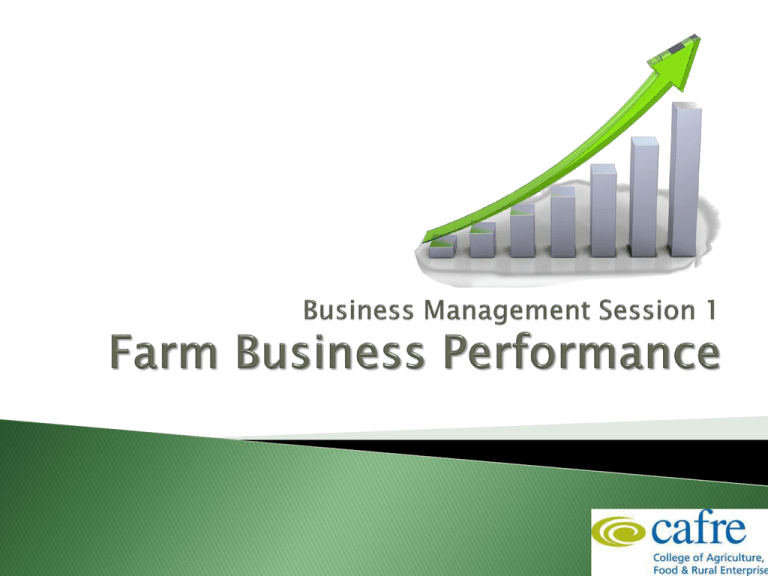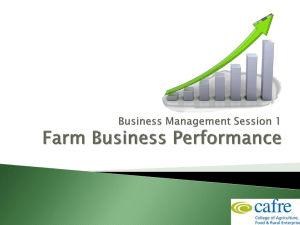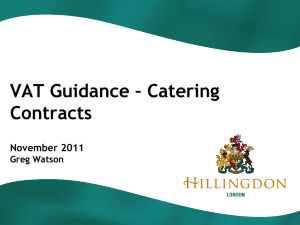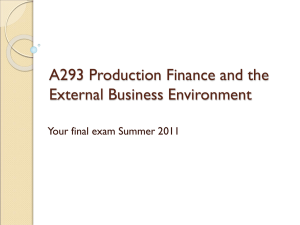Dairy Business Management
advertisement

Night 1 Night 2 Night 3 Night 4 ◦ Farm Business Performance Management ◦ Record-keeping ◦ Costs and Receipts ◦ Management accounts ◦ Profit and Cashflow ◦ Benchmarking ◦ Banking and Finance Introduction What is Farm Business Management? Business Goals and Objectives Record Keeping VAT – Rules, Rates, Records Accounts – Profit and Loss, Balance Sheet Tax Returns and Payments Group Exercise What is farm business management? What has to be managed? The control of farm resources (inputs) to reach a goal (outputs) Resources include: Land Labour Capital, e.g.machinery, buildings, livestock, feed, medicines etc. Decision making No Control Weather Concentrate Price Fertiliser Price Milk Price Regulations Control Fertility Cow Genetics Forage System Farmer = Manager Typical Organisational Chart Large businesses Farmer? M.D. M.D. Worker Mechanic Management Builder Plumber Vet Stockman Manager Workers Book keeper Goals What do you want out of the business? A decent standard of living Education for children A healthy business to pass on to next generation Top-class herd, flock, crop Provision for retirement Enough free time to enjoy life Goals are broad statements that show where you want to be after some period of time. Objectives are the specific steps that must be taken in order to reach goals. Group Exercise Short term – goals that you would like to accomplish within the next year Intermediate term – goals to accomplish within one to 5 years Long term – goals that require more than 10 years to accomplish What are your goals? The Importance of Planning 11 Farm Records Why keep records? What records do I need to keep? What records are legally required? How long must they be kept? It’s the Law For VAT and Tax forms (HMRC) For measuring performance For making decisions; ◦ Details for management decisions: feeding, breeding, culling, selection, purchases, expansion, etc. 13 Farm Records - Physical There is a crossover between the Legal requirements, FQAS, NAP, Cross Compliance and other schemes. Herd Records - Law Fertiliser used – Law, NAP Regulations Livestock feed supplies – Law, FSA, FQAS Veterinary Medicine records - Law Chemical / Pesticide records - Law - Births, Deaths, Movements, Imports / Exports Documents used to complete a tax return, Bank statements and cash transactions Loan agreements Credit card receipts Sales and purchase invoices Investments Private expenses taken from account – Personal Drawings VAT accounts, import or export documents Farm Records - Other Personnel File Wages & National Insurance contributions etc. Retention Period for Financial Records – 6 years after the current year Contract & employee records Retention Period – 7 years after employment ends Health & Safety Risk Assessment reports, Accident Books Retention Period – 12 years Insurance Employers liability insurance certificates Retention Period – 40 years Group Exercise What information needs to be recorded before you can assess the performance of your own farm? Performance records/stock records Information to record: • Calving dates/ heat detection dates • Individual cow records e.g. yield, no. of mastitis cases • Breeding and fertility details • Livestock feed levels, weights • Field and crop records • …. Used for Benchmarking Gross margin, ppl, £/cow, £/ha Milk yield Milk composition Milk from forage and concentrate Fertility/calving interval Etc. All this information will help to create benchmarking reports for the enterprise VAT is a tax added to the value of certain goods (fertiliser) and services (auction fees). When certain goods and services are sold, VAT is collected by those selling. This money is then sent to HM Revenue and Customs (HMRC) www.hmrc.gov.uk/vat/ for more information 20 Must submit online You usually submit a VAT Return to HMRC every 3 months. The VAT Return records information for the accounting period like: ◦ ◦ ◦ ◦ your total sales and purchases the amount of VAT you owe the amount of VAT you can reclaim your VAT refund / payment You must submit a VAT Return even if you have no VAT to pay or reclaim. 21 Goods and services can be classified into five VAT groups:1. Standard rate - currently 20% 2. Reduced rate - currently 5% 3. Zero rate - this is not the same as exempt or outside the scope of VAT (0%) 4. Exempt – no VAT but within the VAT system 5. Outside the scope of VAT Vat Categories Summarised 20 23 Financial Statements ◦ Profit & Loss Account ◦ Balance Sheet Almost all farmers are either Sole Traders or in a Partnership and therefore are not required by law to keep the above accounts, but it is normal practice Your accountant will advise Adequate records are needed for completion of Self Assessment tax return and VAT returns The Profit and Loss Account summarises the financial transactions during the accounting period (a year). A measure of how well the business is performing Used to calculate the profit generated and the tax due TOTAL INCOME Sales + Subsidies (including SFP) + Sundry receipts - Opening valuation (livestock, crops, fodder, feedstuffs and goods in store) COST OF + SALES Purchases – Closing valuation = GROSS PROFIT - OVERHEADS OR FIXED COSTS = NET PROFIT Sales Milk Sales Livestock Sales Single Farm Payment TOTAL INCOME Cost of Sales 235,000 Opening stock valuation Purchased feed Dairy variable costs Forage costs Closing stock valuation GROSS PROFIT Fixed Costs 150,000 67,500 10,000 20,000 97,500 150,000 97,500 137,500 Power and machinery Sundry overheads Depreciation Paid labour Conacre Bank charges / interest NET PROFIT 200,000 20,000 15,000 32,000 10,000 19,000 12,000 8,000 6,000 87,000 50,500 Shows the financial position of the farm business. Only valid on the day it is completed. Shows what the farmer owns and what he owes. The balance sheet lists: The ASSETS of the business – fixed and current. The LIABILITIES of the business – current and long-term. How the business is FINANCED – its capital. Value of Assets Value of Liabilities = NET WORTH LIABILITIES ASSETS Long/medium term liabilities Mortgage Hire purchase Fixed assets £55,000 24ha land @ £25,000 Machinery and £8,000 equipment Breeding livestock Merchant creditors £40,000 £30,000 Current assets Current liabilities Overdraft £600,000 £15,000 Store cattle £4,000 Feed in store NET WORTH £610,500 TOTAL LIABILITIES £692,500 TOTAL ASSETS £20,000 £2,500 £692,500 Tax must be paid on earnings and other incomes You must file a tax return each year by; Your accountant can file the return for you or you can do it yourself You must pay tax on profits HMRC will not wait for payment! ◦ 31st October by paper or ◦ 31st January online The current official HMRC tax year is from 6th April 2014 to 5th April 2015, although businesses can have different tax years. Tax rates: ◦ Everyone can earn £10,000 per year (Personal Allowance) before tax is applied ◦ Pay 20% on remaining income up to a total of £41,865 ◦ Higher rate of 40% from £41,866 to £150,000 ◦ Additional rate 45% Over £150,000 If the business is a Partnership, each partner has a Personal Allowance Managing your business is crucial to success. Good financial and physical records are needed to manage and plan properly. Failing to plan is planning to fail!




